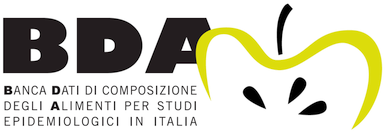Thanks to funding by the Italian Association for Research on Cancer (AIRC), in collaboration with various research groups in Italy, the “Food Composition Database for Epidemiological Studies in Italy”, by Salvini, Parpinel, Gnagnarella, Maisonneuve, Turrini, was published in 1998. The project was started because of the need of epidemiologists for a large database with information about the most important nutrients in the main food items consumed in our country. The role of diet in the prevention and as a cause of chronic disease can be assessed by large epidemiological studies: thus, food composition databanks are needed to transform dietary consumption information into nutrients.
The database was compiled according to a well defined methodology, starting from food composition data of the National Nutrition Institute (INN) of Rome (1989), from other Italian and foreign sources (Fidanza, McCance&Widdowson’s, USDA) and from scientific papers.
BDA provides the composition in terms of energy and nutrients (water, macronutrients, 6 minerals, and 11 vitamins) for 788 food items. The printed version includes methodological chapters and individual information sheets. It is possible to download the volume of the first version in pdf format (download book) and to request the updated data file in text format (ascii), by sending a request by e-mail.
BDA has continued to evolve and update, adapting to the guidelines of the international non-profit association EuroFIR AISBL (Association Internationale Sans But Lucratif), that originates from the European project EuroFIR (European Food Information Resource), a network of excellence focusing on food information resources.
The update were published in 2008 and 2015:
BDA v1.2008 and BDAv2.2008 – The following food groups were updated: milk and milk products; meat and fish (fresh or preserved); alcoholic and non alcoholic beverages; eggs; fats. Within these categories, compared to the 1998 version, the following components were added: aminoacids, some fatty acids (in particular omega-3), sugars, minerals and trace elements (magnesium, copper, selenium, chlorine, iodine, manganese, sulfur), vitamins (pantothenic acid, biotin, vitamin B12).
BDA v1.2015 – The following food groups were updated: fresh fruit and berries, cooked or canned fruit, dried fruit and seeds, fruit flours, fruit juices and drinks. Within these categories, compared to the 1998 version, the following components were added: aminoacids, some fatty acids (in particular omega-3), sugars, minerals and trace elements (magnesium, copper, selenium, chlorine, iodine, manganese, sulfur), vitamins (pantothenic acid, biotin, vitamin B12, vitamin K).
Furthermore, BDA coordinates NUTRIRETE.lab, a network to collect food composition data, produced by public and private laboratories developed as part of Work Package 4 (WP4) of the Operating Unit 4 (OU 4 – SIAGRO) of the QUALIFU project (Qualità Alimentare e Funzionale), funded by the Ministry of Agriculture and Forestry (MIPAAF) (M. D.2087/7303/09).
